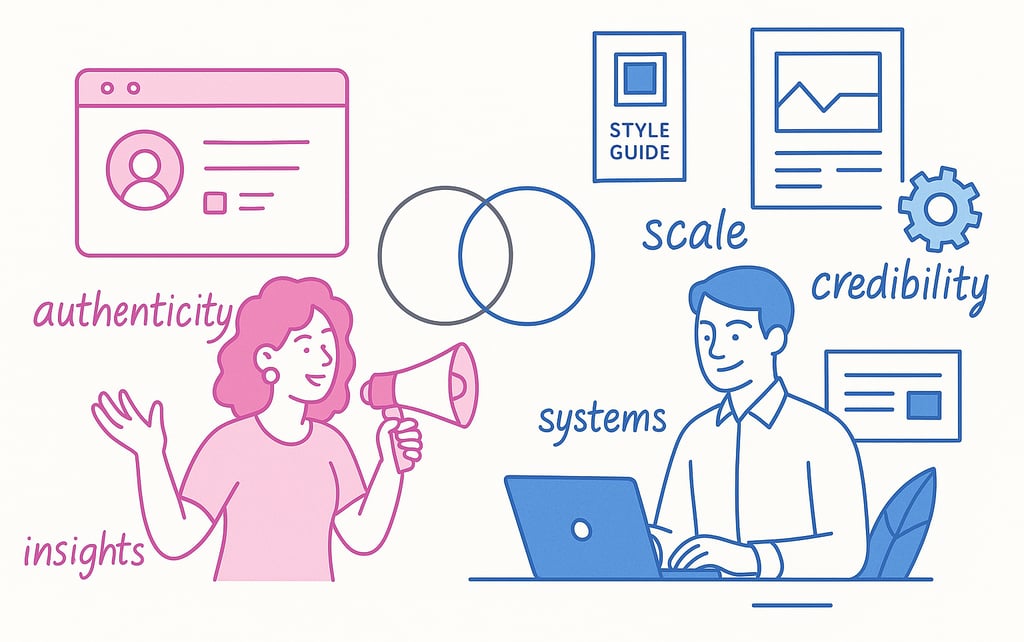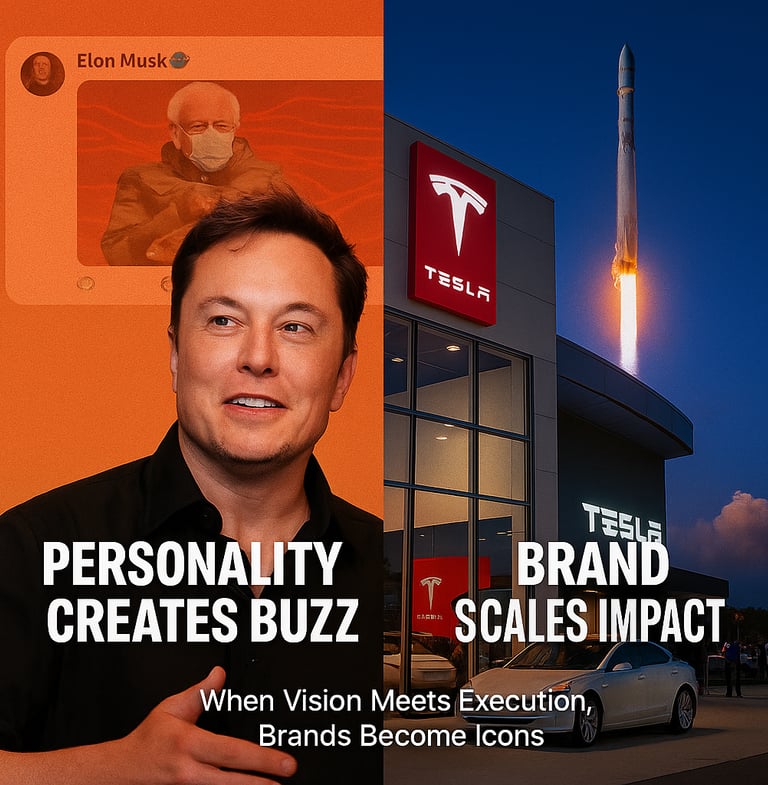Personal Brand vs. Business Brand: Key Differences and When to Use Each
GROWTH
5/15/20255 min read


In a world where buying decisions are influenced by trust as much as features, the conversation around personal and business branding is more relevant than ever. At Briskfab, we work with growth-stage companies who often ask:
"Should I focus on building my personal brand or the company's brand?"
The answer isn’t binary. It’s strategic.
Let’s unpack the key differences, where each shines, and how to make the right call depending on your growth stage, goals, and go-to-market motion.
The Real Difference Between Personal and Business Branding
Personal branding is about you—your expertise, your story, your values. It creates human connection, accelerates trust, and brings authenticity to the forefront.
Business branding is about your company—its mission, message, and market presence. It offers consistency, scale, and transferability across teams, markets, and time.
Why does this distinction matter?
People trust people faster than they trust logos
Business brands scale more efficiently and build enterprise value
According to recent studies:
Companies with consistent branding see a revenue boost of up to 23%
60% of buyers prefer companies led by recognizable, visible leaders
The conclusion? You need both, but at different times and in different ways
Personal Branding: Your Trust Accelerator
A strong personal brand includes:
Your unique perspective and area of expertise
Your communication style and personality
Your professional journey and narrative
Your visible and consistent values
Take Elon Musk: his personal brand has more reach than any of his companies. He builds trust, sparks debate, and moves markets—all by speaking directly to the world.


When Personal Branding Wins
Lead with your personal brand when:
You're early-stage. Trust needs to come before budget.
You have a compelling founder story or differentiated POV.
You're selling high-ticket B2B solutions where relationships drive outcomes.
You work in a thought leadership category—AI, security, and consulting.
You’re competing in a saturated market and need to stand out.
A SaaS founder posting consistently about team-building, GTM challenges, or product decisions can generate a pipeline long before ad spend kicks in.
Why It Works
Trust acceleration: You’re human. Logos aren’t.
Content agility: No approvals. Just insight at speed.
Network magnet: Media prefers people over entities.
Vision platform: You can challenge norms and spark new conversations.
Authentic connection: Your values and story create emotional resonance.
Lower startup cost: Content, not cash, builds visibility.
Real Limitations
Scalability: There's only one of you. Delegation is tough.
Transferability: If you exit, the brand equity often leaves too.
Dependency risk: Teams overly reliant on founder visibility can stall.
Blurred boundaries: Personal opinions may not always align with business goals.
Business Branding: Your Scalable Asset
A strong business brand includes:
A clear mission and defined values
A consistent visual identity (logo, colors, design)
A strategic messaging framework
A seamless customer experience
HubSpot offers a great example. From product to support to marketing, every touchpoint reinforces a single brand voice. The result? Cohesion, trust, and scale.
When Business Branding Takes Priority
Shift focus to business branding when:
You're growing beyond founder-led sales into repeatable systems.
You're scaling into new geographies or verticals.
You're raising capital or exploring M&A.
You're hiring and need internal alignment.
You’re targeting enterprise buyers who expect polish and professionalism.
A B2B platform selling to enterprise buyers must demonstrate stability, reliability, and long-term vision. A strong business brand supports these outcomes.
Strategic Advantages
Built for scale: Style guides, brand books, and systems ensure consistency.
Transferable value: Equity that lasts beyond the founder.
Team alignment: Everyone knows how to show up.
Multi-channel growth: Extend into new markets and products seamlessly.
The Honest Challenges
Slower trust curve: Logos take longer to win hearts.
Creative friction: Legal and brand reviews slow down content speed.
Harder to differentiate: Without intentional strategy, business brands blur together.
Higher initial cost: Brand systems and visuals aren’t cheap to do well.
The Dual-Engine Approach: Why Smart Teams Blend Both
The smartest strategy isn’t personal vs. business. It’s personal and business—used at different stages of the buyer journey.
Top of Funnel: Personal Brands Drive Reach
Use founder and team voices to start conversations, spotlight challenges, and build emotional relevance.
LinkedIn posts from individuals often outperform company pages, because people engage with people.
Middle of Funnel: Business Brands Build Credibility
As prospects evaluate solutions, shift them toward your business brand. Case studies, demos, and resources need structure and polish.
Bottom of Funnel: Both Engines Fire
Use the power of personal relationships plus corporate credibility to close deals. This combo is especially effective in enterprise sales.
Strategic Identity in Action
To execute the dual-engine approach well, consistency and authenticity are key.
Visual Consistency
Keep visuals aligned across platforms—logos, color palettes, design systems. Whether it’s a personal post or a business asset, ensure it reflects your brand identity.
Message Synchronization
Make sure both personal and business messaging ladder up to the same strategic goals. You can vary tone, but not the core message.
Value Alignment
Values aren’t just internal memos. They should show up in your content, decisions, and customer experience.
If your mission is customer-centricity, prove it—publicly, repeatedly.
Social Media: Your Distribution Engine
Whether you're building a personal brand, business brand, or both—social platforms are where visibility is won.
For Personal Brands
Use platforms like LinkedIn or X (formerly Twitter) to:
Share insights from your work
Comment on industry trends
Offer candid reflections or behind-the-scenes looks
Spark conversations around customer pain points
For Business Brands
Use channels like LinkedIn Pages, YouTube, and newsletters to:
Share tutorials, case studies, and product updates
Promote team stories and customer testimonials
Reinforce visual consistency and tone of voic
Research shows content shared by employees gets 8x more engagement than the same content from brand pages. So, encourage your team to participate
Practical Brand Strategy by Growth Stage
Early-Stage (Pre-Series A)
Start with a strong founder brand
Build foundational business assets early: logo, tone, narrative
Use personal content to link back to the business
Growth-Stage
Systematize your business brand with style guides and processes
Encourage leaders across functions to build their personal brands
Segment brand strategy by market, some will respond more to people, others to professionalism
Scale-Up
Institutionalize your business brand, make it bigger than any one person
Use personal brands to launch new verticals, products, or ideas
Plan succession to ensure the business doesn’t collapse if the founder steps back
Decision Framework: How to Choose Your Focus
Ask yourself:
What’s your growth stage? Early teams benefit most from personal visibility.
What’s working today? If your founder’s posts drive pipeline, don’t stop. Double down.
What resources do you have? Personal brands cost time. Business brands cost money.
What’s your sales motion? Long, complex B2B sales usually require both.
What’s your endgame? If you’re building to exit, you’ll need a brand that can live beyond you.
Final Take: Your Brand Is Your Growth Strategy
Your personal brand is the spark. Your business brand is the fire.
Used well, they work in harmony to drive awareness, build a pipeline, and close deals.
Personal brands create trust, fast
Business brands deliver scale, credibility, and equity
Together, they future-proof your company
Whether you’re just starting out or scaling globally, the smartest teams don’t choose one engine. They run both strategically, authentically, and in sync.
At Briskfab, we help growth-stage teams build this dual-engine system from the ground up.
Need help building your brand engine? Let’s talk!
